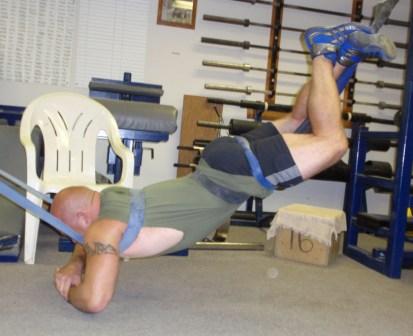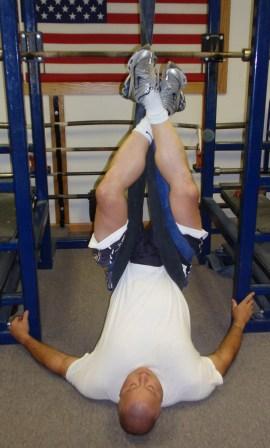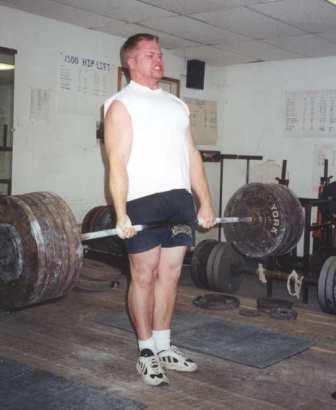Taking Care of Your Back – Part 2
Part 2 – Be Sure To Limber Up
by Al Myers
I initially was going to title this part Stretching. But that didn’t define it the way I wanted it to. Stretching to me means doing movements like touching your toes or light calisthenics. I next thought I would title this part Flexibility, as that could result from many things, including stretching. This still didn’t fit the message I wanted to convey. I finally (with much deep thought!) decided to use the expression “Be Sure to Limber Up”, because that fits exactly what the first part of my Thursday workouts are all about.
As for my opinion on stretching, I believe a little is necessary but to much is harmful in developing maximum strength. I know this is a BOLD statement, and there are probably many lifters who would disagree with me on this. Bill Clark once told a training partner of mine Mark Mitchell, when Mark trained at Clark’s Gym several years ago, that stretching the muscles in excess is like repeatedly stretching a rubber band – eventually it will SNAP. I couldn’t agree more. I have always been prone to hamstring pulls, and through the early years of my training I did about everything to safeguard against this injury, including aggressive hamstring stretching. Sure I got more flexible – but it didn’t solve my problem of enduring hamstring injuries. Being able to place your hands flat on the floor with the legs straight is beyond what is needed to be a competitive lifter (unless you are in training for the Mansfield Lift!). Excessive flexibility, beyond what is required in doing a specific lift, doesn’t help in being strong in that lift. In fact, having just enough flexibility to “remain tight” in the bottom portion of a lift will enhance your strength in a lift. Think about the squat – do you WANT to be tight and ready to recoil when you break the legal depth? I sure do. This reminds me of a story my brother-in-law Bob Burtzloff once told me that re-enforces my opinion on this. Many years ago Bob experimented with training the Bench Press using a cambered bench press bar (also known as a McDonald Bar). It allows the lifter to increase the range of motion on the bench press, with the hands going lower than the chest when the cambered portion of the bar touches the chest. Bob first thought training through this INCREASED range of motion would increase his Bench Press. It did the opposite and made his Bench Press go down. When he went back to a regular bar he didn’t feel the tightness in his chest and shoulder muscles when at the bottom position.
However, stretching is still part of my Thursday workout. I think you need a balance in flexibility to optimize your lifting abilities. On the other hand, I have seen lifters who were so in-flexible that they couldn’t even properly perform some of the All-Round Lifts that require flexibility. In these cases, spending a little time stretching would help their performance.

Chad Ullom performing a stretch with the Jump Stretch Bands that Dick Hartzell called "the rack". Chad is completely suspended off the floor and his back is being "stretched" by band tension.
For me, two days after a heavy back workout is when my legs and back are the most sore. I start off this workout with some cardio, which usually includes time on my recumbent exercise bike. This “loosens up” those bound-up leg muscles and hips, along with giving me some needed cardiovascular fitness. After getting a good sweat going, I’ll proceed to wind down with some stretching. Nothing fancy here – just 20 minutes of whatever stretches I feel like doing at the time. Next I’ll proceed to the “bread and butter” exercise that limbers up my back – Suspended Band Stretching. I learned this “secret exercise” several years ago at the 2003 USAWA National Championships in Youngstown, Ohio. This meet was hosted at the Jump Stretch training facility, the birthplace of the Jump Stretch Bands. Known as “the rubberband man”, Dick Hartzell showed several of us after the meet a very unique use of the Jump Stretch bands that I had never seen before. It involved using the bands to decompress the vertebrae of the back by using band tension. Once I got home I immediately purchased a pair of the Big Black Monster Bands from Jump Stretch so I could replicate this movement in my gym. I wouldn’t really call it stretching. But I’ll tell you, 15 minutes of hanging by the hips with these bands attached your back will be fully “limbered up”. Any pain from tight muscles in your back will be gone.
More of this workout and the story “Taking Care of Your Back” tomorrow with – Part 3, Have Strong Abs

